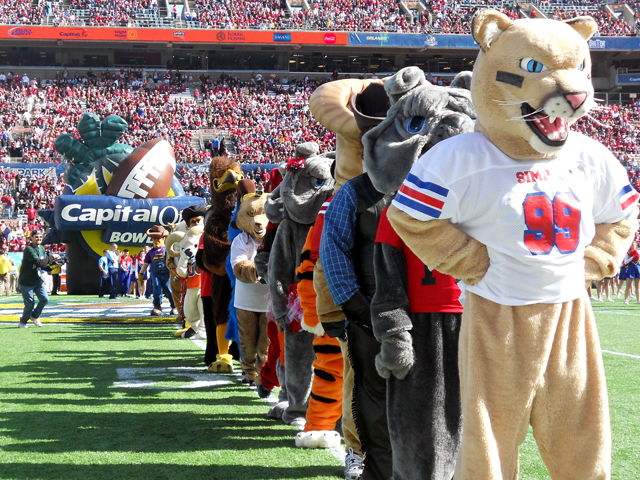High School Mascots Head Off to Camp

The Universal Cheerleading Association has seen an increase in enrollment at its summer mascot camps as more cheer coaches opt for sending their furry performers while trying out more budget-conscious approaches to train their cheerleading squads. Photo by Katie Raymond.
By Lynda Gonzalez
For Reporting Texas
At the Texas high school summer camps run by the Universal Cheerleaders Association, more costumed mascots than ever are perfecting their characters amid the pompoms and pyramids as the options for cheerleading instruction expand.
One reason is that, in today’s budget-conscious times, it’s cheaper for schools to send one Cowboy or Hawk or Antler to build their sidelines skills than a dozen cheerleaders.
UCA, the largest cheer and dance instruction company in the world, has seen a steady rise in mascot enrollment in the last four years, with 623 in its Southwest region (with Texas bringing the vast majority of campers) enrolled last summer, compared with 542 in 2008. Word-of-mouth has contributed to the climb in numbers, said Benji Gray, UCA’s mascot director.
“For the past four years, our numbers have continually gone up,” Gray said. “And that might not be by much — it might only be five or 10 kids more per year — but that’s still an increase and a boost to the program. Schools end up seeing other schools, coaches may be seeing other coaches and say, ‘Oh, we saw your mascot, what are y’all doing?’”
UCA charges just under $300 to register a student for cheer or mascot training, and that cost includes food and housing, which is often at a university dorm facility. That’s much cheaper than the $3,600 schools can pay to send a dozen cheerleaders or dancers to summer camp to craft competitive routines or improve skills for leading crowds at events.
One alternative coaches choose is to pay $500 instead for a pair of UCA trainers travel to a high school, Gray said. Such private camps, while providing a cheaper route, also offer customized attention to squads.
Coppell High School opts for private instruction from Spirit of Texas to train the school’s National Cheer Association nationally ranked team, according to assistant cheer coach Jodie Deinhammer.
“We get more out of private camps overall, [since] we have all the coaches for our squad,” she said, adding that her team wasn’t “getting anything out” of the bigger camps. “The girls weren’t learning anything new. So… we went to the private camp and they took what we had already, and they customized the camp for that so we could learn some different stuff.”
But Caroline Roberson of Coppell High School paid her way to attend UCA’s mascot camp because the camp her spirit team attends doesn’t offer mascot-specific instruction. There, she learned to embody the spirit of Cowboy Carl and learned skills that she hopes will help her become a collegiate mascot someday.
“UCA helps me develop my skills and lets me connect with other mascots from around the area,” Roberson said. “I have to say that my favorite part would be the people I met. They all were fun people who thought and acted just like me. It’s cool to be able to grow close to other people who have the same amount of passion to be a mascot.
Gray said the mascot is especially important to a school’s brand.
“The mascot is a symbol and foundation of your institution,” he said. “A mascot should embody everything that your institution represents — the academics, the extracurriculars, the mission statement, the athletics. That should be the one thing that you want to make sure is as wholesome and perfect as possible.”
Cheerleading has an enduring presence in Texas because of the sport’s long history in the state, said Denise Martin, the editor of Texas Cheerleader Magazine. Although the sport of cheerleading originated in Minnesota, it wasn’t until Lawrence Herkimer created his summer cheer camp in Huntsville in 1948 that cheerleading — and mascots — truly became part of Texas high school culture.
“In addition to that, he did see the importance of training the mascots how to keep the crowds involved and how to interact with their spirit teams,” she said. “He’s the one who created the spirit stick, held the patent for the pompom before he sold it off to someone else, and if you’ve ever heard of the Herkie jump, it’s named after him.”
Gray said that Texas is the biggest market for UCA, which offers the most cheer and mascot camps in the state.
“At Texas, y’all put such an emphasis on high school football, and that accounts for everything,” said Gray, who is originally from Tennessee [and a colleague of this reporter’s roommate]. That’s the cheerleading, that’s the band, the mascot, the whole nine yards,” he said. “That kind of emphasis is not at all seen at other camps.”